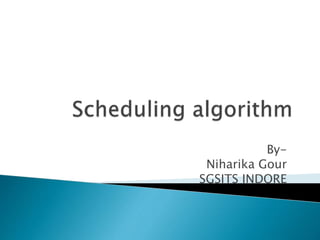
scheduling.pptx
- 2. First Come First Serve (FCFS) is an operating system scheduling algorithm that automatically executes queued requests and processes in order of their arrival. It is the easiest and simplest CPU scheduling algorithm. In this type of algorithm, processes which requests the CPU first get the CPU allocation first. Average waiting is high
- 3. Advantage- The simplest form of a CPU scheduling algorithm Easy to program First come first served Disadvantages of FCFS It is a Non-Preemptive CPU scheduling algorithm, so after the process has been allocated to the CPU, it will never release the CPU until it finishes executing. The Average Waiting Time is high. Short processes that are at the back of the queue have to wait for the long process at the front to finish. Not an ideal technique for time-sharing systems. Because of its simplicity, FCFS is not very efficient.
- 4. Shortest Job First (SJF) is an algorithm in which the process having the smallest execution time is chosen for the next execution. This scheduling method can be preemptive or non-preemptive. It significantly reduces the average waiting time for other processes awaiting execution
- 5. Pros – SJF is frequently used for long term scheduling. It reduces the average waiting time over FIFO (First in First Out) algorithm. SJF method gives the lowest average waiting time for a specific set of processes. It is appropriate for the jobs running in batch, where run times are known in advance. For the batch system of long-term scheduling, a burst time estimate can be obtained from the job description. For Short-Term Scheduling, we need to predict the value of the next burst time. Probably optimal with regard to average turnaround time.
- 6. Cons- Job completion time must be known earlier, but it is hard to predict. It is often used in a batch system for long term scheduling. SJF can’t be implemented for CPU scheduling for the short term. It is because there is no specific method to predict the length of the upcoming CPU burst. This algorithm may cause very long turnaround times or starvation. Requires knowledge of how long a process or job will run. It leads to the starvation that does not reduce average turnaround time. It is hard to know the length of the upcoming CPU request. Elapsed time should be recorded, that results in more overhead on the processor
- 7. Earliest Deadline First (EDF) is an optimal dynamic priority scheduling algorithm used in real-time systems. It can be used for both static and dynamic real-time scheduling. EDF uses priorities to the jobs for scheduling. It assigns priorities to the task according to the absolute deadline. The task whose deadline is closest gets the highest priority. The priorities are assigned and changed in a dynamic fashion. EDF is very efficient as compared to other scheduling algorithms in real-time systems. It can make the CPU utilization to about 100% while still guaranteeing the deadlines of all the tasks. EDF includes the kernel overload. In EDF, if the CPU usage is less than 100%, then it means that all the tasks have met the deadline. EDF finds an optimal feasible schedule.
- 8. Pros- It gives Maximum CPU Utilization It met up deadline of all tasks It allows both premptive and non preemptive mode- Cons- Transient Overload Problem Resource Sharing Problem Efficient Implementation Problem
- 9. Rate monotonic scheduling is an optimal fixed-priority policy where the higher the frequency (1/period) of a task, the higher is its priority. This approach can be implemented in any operating system supporting the fixed-priority preemptive
- 10. Pros- It is easy to implement. If any static priority assignment algorithm can meet the deadlines then rate monotonic scheduling can also do the same. It is optimal. It consists of a calculated copy of the time periods, unlike other time-sharing algorithms as Round robin which neglects the scheduling needs of the processes. Cons-: It is very difficult to support aperiodic and sporadic tasks under RMA. RMA is not optimal when the task period and deadline differ.
- 11. The name of this algorithm comes from the round-robin principle, where each person gets an equal share of something in turns. It is the oldest, simplest scheduling algorithm, which is mostly used for multitasking. In Round-robin scheduling, each ready task runs turn by turn only in a cyclic queue for a limited time slice. This algorithm also offers starvation free execution of processes.
- 12. Pros- It doesn’t face the issues of starvation or convoy effect. All the jobs get a fair allocation of CPU. It deals with all process without any priority If you know the total number of processes on the run queue, then you can also assume the worst-case response time for the same process. This scheduling method does not depend upon burst time. That’s why it is easily implementable on the system. Once a process is executed for a specific set of the period, the process is preempted, and another process executes for that given time period. Allows OS to use the Context switching method to save states of preempted processes. It gives the best performance in terms of average response time.
- 13. Cons- If slicing time of OS is low, the processor output will be reduced. This method spends more time on context switching Its performance heavily depends on time quantum. Priorities cannot be set for the processes. Round-robin scheduling doesn’t give special priority to more important tasks. Decreases comprehension Lower time quantum results in higher the context switching overhead in the system. Finding a correct time quantum is a quite difficult task in this system.